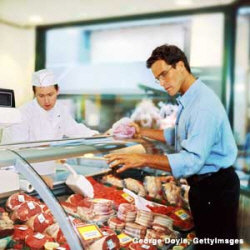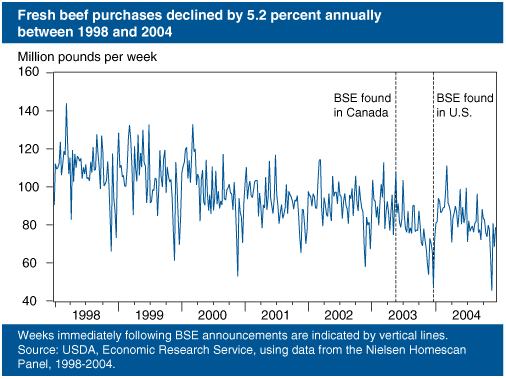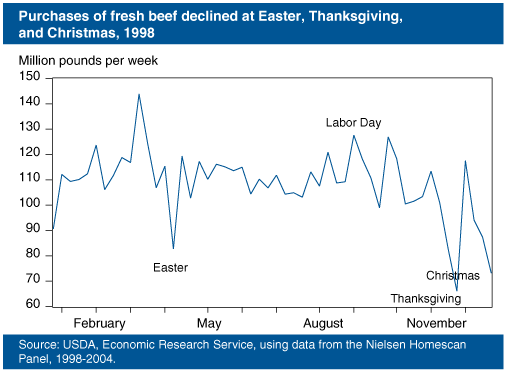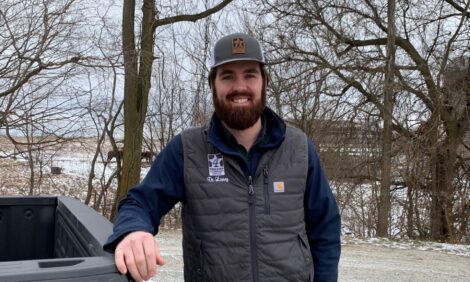



U.S. Consumers Had Short-Term Response to First BSE Announcements
By Fred Kuchler and Abebayehu Tegene, Amber Waves September 2007. USDA. In May 2003, several U.S. Government agencies announced that bovine spongiform encephalopathy (BSE—also known as mad cow disease) had been found in Alberta, Canada.
The following December, agencies reported that a cow in Washington State had BSE. Both of these announcements had the potential to influence consumers’ food choices and retail food markets in the United States.
To measure consumer reaction to those announcements, ERS researchers compared household-level retail food purchases of three types of beef products before and after each announcement to see if consumers reduced their purchases of those products, and, if so, for how long.
Evaluating the impacts of BSE announcements is only the first step in being able to forecast the impacts of other BSE or food safety announcements. Consumers’ reactions to food safety news will be influenced by how much it changes their risk perceptions. Consumers’ beliefs about food safety may change over time, and subsequent announcements could be made under very different conditions.
 |
Food purchase data reveal that the response of U.S. consumers to the 2003 discovery of BSE in two North American cows was limited and dissipated within 2 weeks. Purchase data are a more reliable source of information on consumers’ risk perceptions than consumer surveys. Future food safety announcements may not have the same effect on consumers’ food purchase decisions because consumers’ risk perceptions are likely to change . |
Beef Purchases Fell Briefly in Some Markets
Many consumer surveys were conducted after the BSE announcements. Each survey asked consumers whether they reduced beef consumption following the announcements. The main drawbacks to such surveys are that consumers’ memories of previous food purchases may be error prone and consumers may sometimes feel compelled to answer in the affirmative. Using records of food purchases can be a more reliable means of assessing consumer response.
Food purchases vary throughout the year and evolve over time. Americans habitually consume more of particular foods seasonally and around holidays. Some foods, over time, have fallen out of favor while other foods have taken their places. Change attributed to BSE announcements might be confused with seasonal purchase patterns or longrun trends if underlying patterns created by habit and tradition, as well as evolving preferences, are not taken into account.
ERS researchers used food purchase records to establish a pre-BSE-announcement baseline. Researchers examined three markets—fresh beef, frozen beef, and frankfurters. Frankfurters are more processed than frozen beef (primarily steaks and hamburger patties). More processed food satisfies demands different from those for fresh or frozen beef, so a BSE announcement might have different impacts on consumers’ frankfurter purchases than on other meats.
Using purchase records from the Nielsen Homescan panel, researchers estimated total U.S. beef purchases before and after each announcement. Data were available from 1998 through 2004, extending more than 5 years before the first announcement and a year after the second announcement, allowing comparisons of purchases before and after the announcements. (The Nielsen Homescan panel is a nationally representative panel of households that scan their grocery purchases at home, thereby providing detailed information about each food item, including the purchase date, expenditure, quantity, and attributes that finely differentiate food products. Panel size varied from 7,124 households in 1999 to 8,833 households in 2003.)

Weekly purchases of fresh beef products exhibit strong underlying patterns. Fresh beef includes roasts, steaks, veal, hamburger, ribs, and liver purchased from grocery store meat counters. Fresh beef purchases show a 7-year downward trend, at an average rate of 5.2 percent annually.
Fresh beef purchases also display seasonality with predictable peaks and troughs throughout the year. Troughs in beef purchases occur just before Easter, Thanksgiving, and Christmas. Deep troughs occur exactly as other meats peak (turkey at Thanksgiving). Peaks in early March and around summertime holidays are typical.
Frozen beef and frankfurters display different longrun trends, but all three types of beef display peaks at summertime holidays and troughs prior to Easter, Thanksgiving, and Christmas. The May 20 announcement came just before the Memorial Day peak in purchases and the December 23 announcement came just before the trough at Christmas.

After accounting for trends and seasonality, researchers found that the market for fresh beef provided the strongest case for an impact from the BSE announcements. There is no statistical evidence that the Canadian announcement altered purchase patterns of fresh beef, but purchases during the first 2 weeks after the Washington State announcement were unusually low. Following the announcement, frozen beef purchases fell only for the first week. In contrast, frankfurter purchases dropped in the second week following each announcement, but purchases of no-beef frankfurters also fell, suggesting that unrelated events were more likely responsible for the decline.
Statistical uncertainty precludes a calculation of a reliable estimate of the pounds of fresh beef not purchased because of the BSE announcements. However, the duration of adjustments is clear. There is no evidence of any response beyond 2 weeks after the announcements.
BSE Announcements Did Not Change Consumers’ Risk Perceptions
The short duration of the drop in beef purchases suggests that the announcements did not fundamentally change consumers’ risk perceptions. Assuming that consumers always make food choices under some set of assumptions about risks, they will adjust food choices only if the news changes their risk perceptions. For the BSE announcements to change consumers’ purchase behavior, they would have had either to affect consumers’ perceptions of the likelihood of contracting variant Creutzfeldt-Jakob disease (vCJD)—the human form of BSE, which is strongly linked with exposure to BSE—or to change consumers’ perceptions of the severity of the health outcomes.
Survey evidence on consumers’ BSE risk perceptions supports the conclusion that the announcements did not change consumers’ risk perceptions, although consumers did become more aware of the disease and its human variant. Consumer surveys conducted by the National Cattlemen’s Beef Association asked consumers if they had heard about mad cow disease in the last month. Results indicated that awareness of BSE increased after both the Canadian announcement in May 2003 and the Washington State announcement in December 2003. In the latter case, awareness increased from 61 percent during the quarter prior to the announcement to 96 percent in the quarter after. The survey also asked respondents if they were confident U.S. beef is safe from BSE. The quarterly surveys show the share of respondents confident in beef’s safety increased even after each 2003 announcement.
In addition, U.S. consumers’ knowledge of vCJD seemed to increase after the announcements. For example, Joost M.E. Pennings, Brian Wansink, and Matthew T.G. Meulenberg conducted a survey of consumers in the United States, Germany, and the Netherlands in the last week of January and the first week of February 2001 (before either U.S. BSE announcement but after the first announcement of finding BSE in Germany). The survey characterized U.S. and Dutch consumers as perceiving significantly less risk from beef than German consumers. Survey results also indicated that U.S. consumers were the least informed about vCJD. A survey by researchers at Rutgers University conducted in mid-January 2004 (after both announcements) indicated that, although Americans were still far from fully understanding all the consequences of vCJD, about 75 percent were aware that vCJD could be fatal.
It is surprising that the purported increased awareness of vCJD after the two announcements did not lead to a larger fall in beef purchases. Analysis of the publicity BSE received in Great Britian showed a substantial, but temporary drop in beef demand in the early 1990s. It also revealed a smaller, but persistent reduction in demand. Analysis of the first BSE announcement in Japan showed qualitatively similar results: an immediate drop in beef consumption along with a longer-lived reduction in demand.
The symptoms and outcome of vCJD lead one to speculate that consumers could react negatively to BSE announcements. BSE and vCJD fall into the class of diseases called transmissible spongiform encephalopathies (TSE). All TSE diseases display a prolonged incubation period of months or years and are progressive and debilitating neurological illnesses. There is no treatment for them, and they are always fatal.
If BSE announcements had signaled consumers that beef was unsafe, there were few preventive actions consumers could have taken, other than switching to other meat products. Unlike bacterial contamination, which may be controlled with cooking methods and ordinary hygiene, there are no such safeguards against vCJD. Likewise, bacterial contamination poses a lower risk of illness or death to healthy adults than to those with compromised immune systems, the young, or the elderly. In other countries, vCJD has killed people with no underlying health problems, so being healthy might not offer much defense. Since the first announcements, additional food safety regulations have created greater protection from BSE exposure even if infected cattle were slaughtered. Safety experts have identified particular tissues in an infected animal’s carcass that could be unsafe. As long as those tissues are removed from the food supply at the source, any and all other products derived from the carcass are considered to be safe. But unless consumers are as aware of these safety measures as they are of infected animals, the existence of infected animals could reduce beef consumption.
Government Took Action After BSE Discovery
Given the dreadful nature of vCJD, the limited consumer response suggests that consumers considered additional information in making beef purchase decisions. It appears that as consumers were becoming more aware of BSE and vCJD, they were also getting the message that the risk of exposure or contraction was very low. After the BSE discoveries, several Federal agencies made public statements that the likelihood of exposure to BSE was negligible and that the government was taking steps to reduce the risk even further.
On May 20, 2003, the Food and Drug Administration (FDA) issued a statement saying that the Government of Canada reported that a cow in Alberta had tested positive for BSE. FDA said meat from the infected cow did not enter the food supply and, although there was no evidence of transmission to other animals, the infected cow’s herd mates would be destroyed as a precaution. In its statement, FDA stated, “To date, no case of BSE has ever been found in the U.S., despite years of intensive testing for the disease.”
FDA described USDA’s Animal and Plant Health Inspection Service import prohibitions on cattle and beef from countries that were on the list of BSE-restricted countries (which was immediately amended to include Canada). FDA also highlighted its rule prohibiting mammalian protein from being fed to ruminants; that rule was designed to limit the spread of BSE within the United States even if it did cross the border.
In December 2003, the Centers for Disease Control and Prevention (CDC) issued a statement after the Washington State finding. CDC also described some of the USDA programs—the testing that confirmed the BSE finding, the beef recall, and the epidemiologic investigation into the disease source—as well as the apparent species barrier protecting humans from BSE. In its statement, CDC stated, “The risk to human health from BSE in the United States is extremely low.”
Following the Washington State finding, the Secretary of Agriculture was interviewed by major media outlets and issued public statements describing new programs that USDA was undertaking. For example, on December 30, 2003, the Secretary announced an expansion of the ongoing surveillance program, new regulations that would reduce consumer exposure to BSE if it were in animals intended to be part of the U.S. food supply, and development of a national animal identification system. New regulations included a ban on the use of downer cattle—those too sick or injured to walk—for food uses; a requirement that slaughter plants remove, segregate, and dispose of tissues most likely to harbor the BSE agent, so they do not enter the human food supply; process-control regulations on advanced meat recovery that would prohibit spinal cord tissue; and a regulation prohibiting the use of air injection to stun cattle. A technical team provided daily public statements for several weeks, reporting progress in the epidemiological investigation and on tracing the infected animal’s cohorts. USDA’s Food Safety and Inspection Service provided updates on the meat recall. And, like the CDC and FDA statements, the Secretary of Agriculture reminded the public that “…our food supply and the public health remain safe.”
The limited response to the BSE announcements indicates that consumers did not revise their perceptions of the likelihood of exposure to BSE. They thought the risk was low before and after the announcements. In addition, the negligible likelihood of exposure seemed to have had a larger influence on food choices than increased awareness of BSE and vCJD.
Future Announcements Likely To Generate Different Responses
If consumers always responded the same way to food safety news, one study would provide information allowing analysts to confidently predict consumer responses to other food safety incidents. That is, understanding responses to one BSE announcement would point to responses to another BSE announcement or entirely different food safety issues. Unfortunately, one study is not enough because consumers’ risk perceptions are likely to differ among news events.
Measuring the impacts of the 2003 BSE announcements provides some information about consumer behavior, but also reveals the gaps in our knowledge about the baseline factors that guide food choices and the attributes of risks that are most important to consumers. This case reveals that consumers’ beliefs about the likelihood of exposure to BSE were the most significant factors affecting the outcome. But it does not say how low the likelihood of exposure has to be before it is the only factor that guides consumers’ food choices.
There is no reason for consumers’ ideas about the likelihood of exposure to BSE to be rigid. Since 2003, there have been additional BSE announcements in Canada and the U.S. These newer announcements could have already changed consumers’ risk perceptions. Any additional BSE announcements could also change risk perceptions. And consumers’ response to future food safety news could yield entirely different food choices.
September 2007


